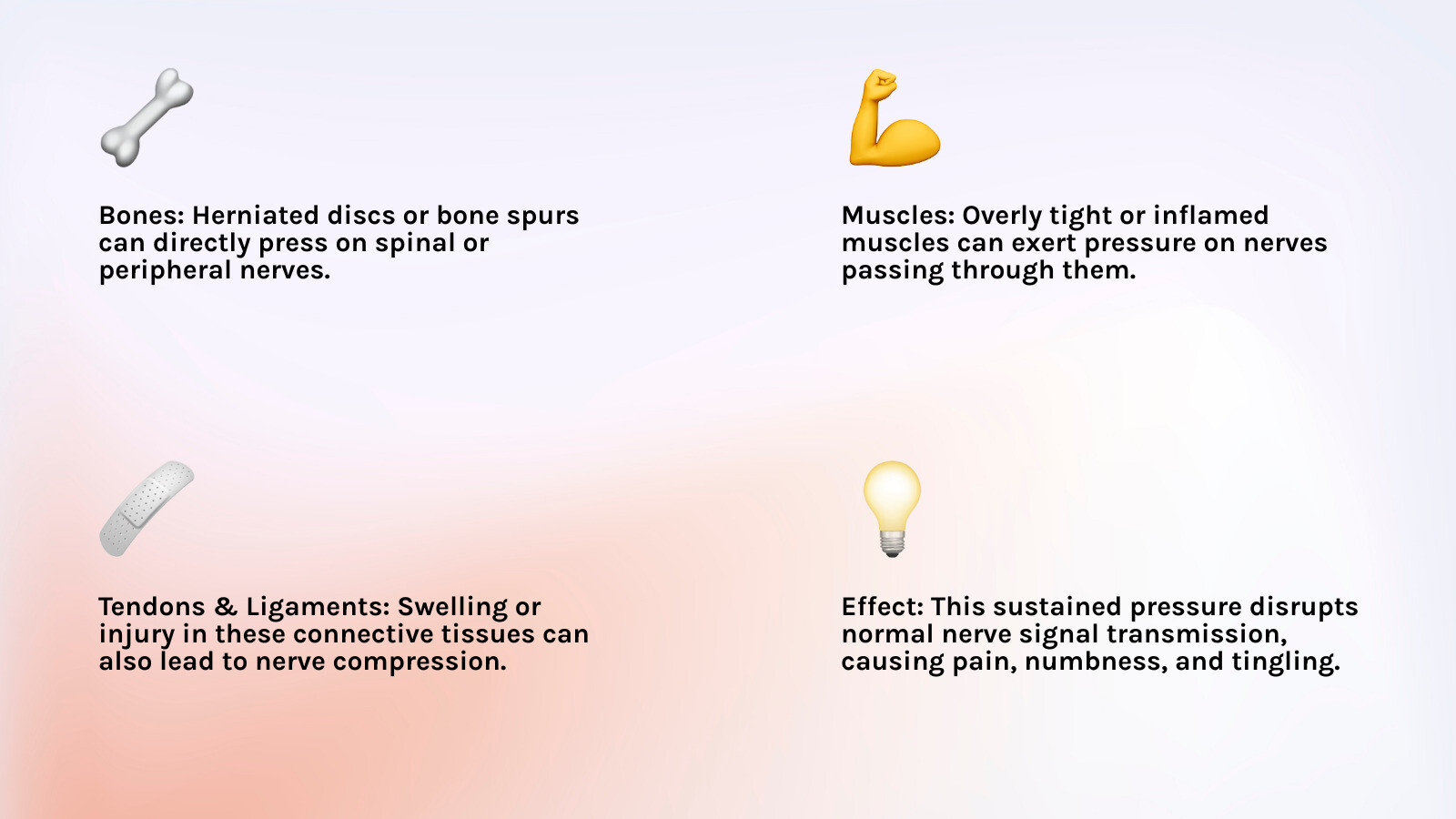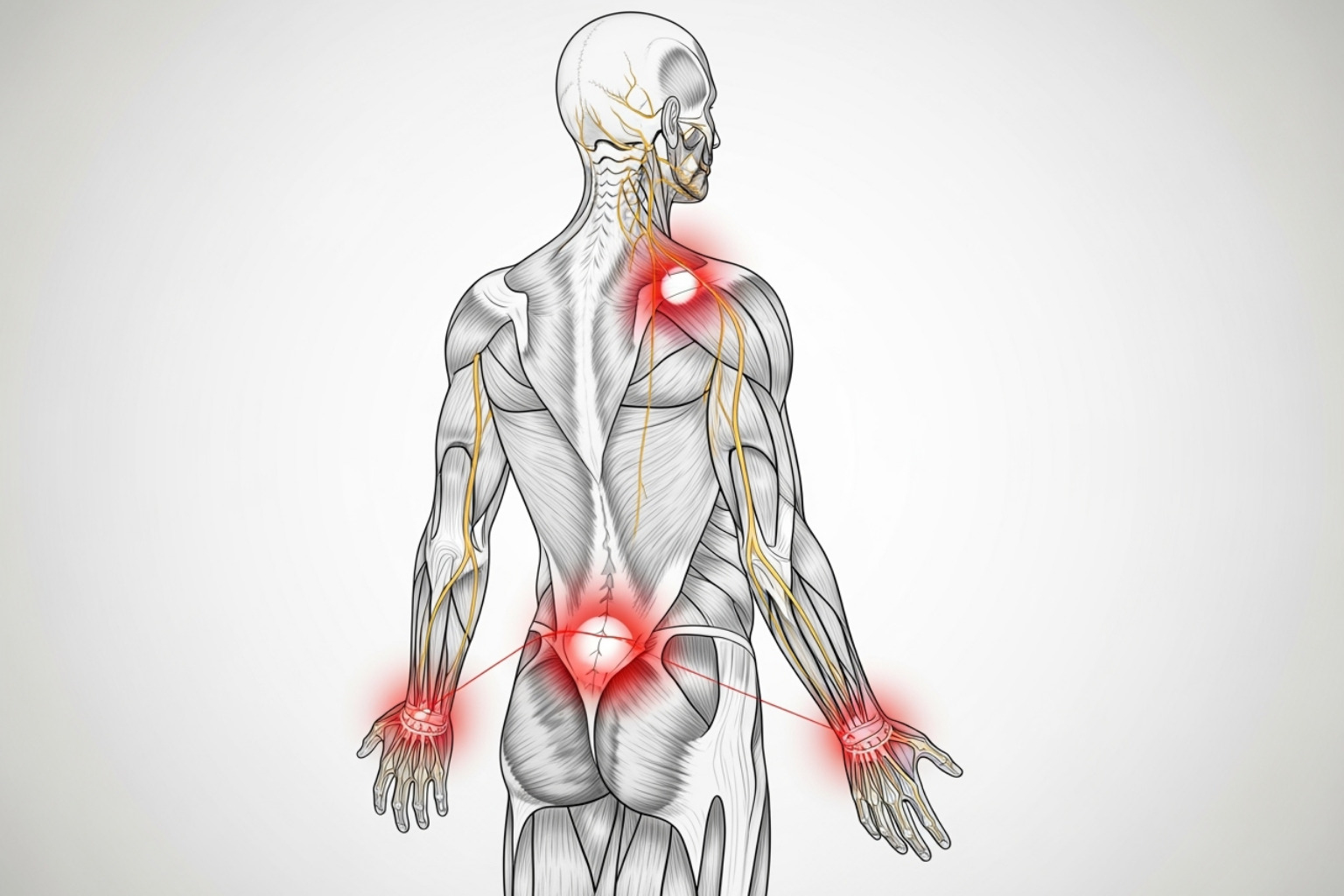What You Need to Know When a Nerve is Pinched
A nerve is pinched when surrounding tissues—like bones, muscles, or tendons—apply too much pressure on it, disrupting its ability to send signals. This compression can happen almost anywhere but is most common in the neck, lower back, and wrists.
Quick Answer: Key Facts About Pinched Nerves
- What it is: Compression of a nerve by surrounding tissues (also called radiculopathy or nerve entrapment).
- Common symptoms: Pain, numbness, tingling, weakness, or a "pins and needles" sensation.
- Typical locations: Neck (cervical spine), lower back (lumbar spine), and wrist (carpal tunnel).
- Common causes: Herniated discs, bone spurs, arthritis, repetitive motion, and injury.
- Healing time: Mild cases often resolve in days to weeks; severe cases may take longer.
- When to see a doctor: If symptoms last more than a few days or you experience sudden severe pain or weakness.
The good news is most people recover from a pinched nerve with rest and conservative care. For many, time and supportive measures, including topical relief options, are all that's needed.
This guide walks you through what happens when a nerve is pinched, how to recognize the symptoms, when to seek help, and how to find relief. I'm Tony Enrico, and through my work with Neuropasil, I've helped thousands find relief from nerve pain. This guide combines clinical research with real-world experience to give you practical steps forward.

Understanding What Happens When a Nerve is Pinched
When a nerve is pinched, it's medically known as radiculopathy or nerve entrapment. This simply means a nerve is being squeezed by surrounding tissue, disrupting the electrical signals it sends. Think of a kink in a garden hose restricting water flow—nerve compression similarly hinders signals, causing pain, numbness, and weakness. This usually affects the peripheral nerves that branch out from your spinal cord.
The pressure often comes from structural changes. A herniated disc, where a spinal disc's soft center pushes out, is a frequent cause. Bone spurs (bony growths) and spinal stenosis (a narrowing of the spinal canal) can also encroach on nerve pathways. Additionally, arthritis causes inflammation and joint changes that can lead to nerve compression.
For a deeper dive into the mechanics, you can explore An overview of pinched nerves from the National Institute of Neurological Disorders and Stroke.
Causes and Risk Factors for Nerve Compression
Certain factors increase your chances of developing a pinched nerve.
- Injury: Sudden trauma from accidents or falls can misalign bones or cause swelling that compresses nerves.
- Repetitive Stress: Hobbies, sports, or work tasks involving repetitive motions can lead to inflammation around nerves over time.
- Age-Related Degeneration: As we age, spinal discs lose height, which can lead to bone spurs and narrowed nerve pathways. Interestingly, many people have this damage without any symptoms.
- Obesity: Excess weight adds stress to the spine and joints, increasing compression risk.
- Poor Posture: Consistently poor posture while sitting, standing, or sleeping puts undue pressure on nerves.
- Medical Conditions: Diabetes, thyroid disease, and rheumatoid arthritis all increase your vulnerability to nerve compression.
- Other Factors: Pregnancy can cause temporary nerve compression due to weight gain and fluid retention. Women are also more prone to carpal tunnel syndrome, possibly due to having smaller carpal tunnels.
Recognizing the Symptoms and Related Conditions
When a nerve is pinched, your body sends clear signals. Symptoms vary depending on the nerve's location and the severity of compression. The most common signs include:
- Pain: Often described as sharp, aching, or burning, and it may radiate along the nerve's path.
- Numbness or Tingling: A "pins and needles" sensation (paresthesia) or a loss of feeling in the affected area.
- Muscle Weakness: Difficulty gripping objects, lifting a limb, or maintaining stability.
Many people find their symptoms worsen during sleep or when holding certain positions.

Common Symptoms When a Nerve is Pinched in the Neck (Cervical Radiculopathy)
When a nerve in your neck is compressed, symptoms often appear in your shoulder, arm, or hand.
- Shoulder and Arm Pain: A deep ache or sharp pain that radiates down the arm.
- Numbness and Tingling: Affects specific fingers or parts of the hand, helping to identify which nerve is involved.
- Weak Grip Strength: Difficulty with fine motor tasks like writing or buttoning a shirt.
For more details, the American Academy of Orthopaedic Surgeons offers information on cervical radiculopathy.
Symptoms of a Pinched Nerve in the Lower Back
A pinched nerve in the lower back (lumbar radiculopathy) often causes symptoms that travel down the leg.
- Low Back and Buttock Pain: Can range from a dull ache to sharp, stabbing pain.
- Radiating Leg Pain: A sharp or burning sensation that travels down the back of the leg, often to the foot. This is commonly called sciatica.
- Numbness in Leg or Foot: Patches of decreased sensation that can feel unsettling.
If you're dealing with this type of pain, find practical tips here: Sciatica SOS: Proven Strategies for Immediate Pain Relief.
Radiculopathy vs. Sciatica: What's the Difference?
These terms are often confused. Here’s a simple breakdown:
- Radiculopathy: The medical term for a nerve root being pinched or irritated anywhere along the spine (neck, mid-back, or low back). It is the cause.
- Sciatica: A symptom of lumbar radiculopathy. It refers specifically to pain, numbness, or tingling that radiates along the sciatic nerve pathway—from the lower back, through the buttock, and down the leg.
Essentially, all sciatica is caused by radiculopathy, but not all radiculopathy is sciatica (e.g., a pinched nerve in the neck causes arm symptoms, not sciatica). Understanding this helps you communicate more clearly with your doctor about your symptoms.
Diagnosis and When to Seek Medical Help
Getting the right diagnosis is the first step toward relief. A healthcare provider will typically start by discussing your medical history and symptoms, followed by a physical examination. During the exam, they will check your reflexes, muscle strength, and sensation to pinpoint the problem.
In some cases, imaging or other tests are needed to see what's happening internally:
- X-rays: Show bone structures, revealing issues like fractures or bone spurs.
- CT Scans: Provide a more detailed view of bones and some soft tissues.
- MRI: The best tool for visualizing soft tissues like herniated discs, inflammation, and direct nerve compression.
- Nerve Conduction Studies and EMG: These tests measure the electrical activity in nerves and muscles to assess nerve function and identify damage.
When to See a Doctor Because a Nerve is Pinched
While many mild cases resolve on their own, you should see a doctor if:
- Your symptoms last for more than a few days without improvement.
- Self-care measures (rest, ice, etc.) aren't helping or symptoms are worsening.
- You experience intense or severe pain that disrupts your daily life.
- You notice sudden or progressive muscle weakness.
For more on understanding nerve pain, see The Root of the Problem: Decoding Nerve Pain.
Emergency Symptoms
In rare cases, a pinched nerve can signal a medical emergency. Seek immediate medical attention if you experience:
- Sudden, severe numbness or weakness in a limb.
- Paralysis or inability to move an arm or leg.
- Loss of bladder or bowel control.
- Numbness in the genital or anal region ("saddle anesthesia").
These symptoms can indicate a serious condition like cauda equina syndrome, which requires urgent treatment to prevent permanent damage.
Your Path to Relief: Treating a Pinched Nerve
The good news is that most people with a nerve is pinched find relief with conservative treatments. Healing time varies—some feel better in days, while others may need weeks or months, but the body has a remarkable ability to heal.

At-Home and Supportive Care
These strategies form the foundation of healing for most pinched nerve cases.
- Rest: Avoid activities that trigger your symptoms to give the area a chance to heal.
- Ice and Heat Therapy: Alternate between cold packs to reduce inflammation and heat to relax muscles. Research confirms the effectiveness of this approach for pain management.
- Posture Correction: Make simple adjustments to how you sit, stand, and sleep to reduce pressure on nerves.
- Gentle Stretching: Once acute pain subsides, gentle movements can improve flexibility and blood flow. Never push into pain. Find examples in our guide: Freedom from the Squeeze: How to Relieve a Pinched Nerve.
- Topical Relief: A nerve pain relief cream can provide targeted comfort. Neuropasil is formulated with natural ingredients like Aloe, Urea, and Menthol to deliver soothing relief directly to the affected area. It's a simple way to manage localized pain from sciatica or carpal tunnel, helping you stay active. Always follow product instructions.
When to Consider Medical or Professional Care
If at-home care isn't enough, professional help can make a significant difference.
- Physical Therapy: A physical therapist can design a personalized program of stretches and strengthening exercises to relieve pressure and prevent future issues.
- Prescription Medications: A doctor may prescribe stronger anti-inflammatory drugs, muscle relaxants, or oral corticosteroids to manage pain and inflammation.
- Supportive Devices: A wrist splint, cervical collar, or back brace can limit motion and allow the affected area to heal.
- Corticosteroid Injections: These injections deliver powerful anti-inflammatory medication directly to the nerve, providing temporary but significant relief.
- Surgery: This is considered when conservative treatments fail or if there's progressive muscle weakness. Modern, minimally invasive procedures can remove herniated discs or widen nerve pathways to relieve pressure.
Frequently Asked Questions about Pinched Nerves
Here are answers to some of the most common questions about nerve compression.
How long does it take for a pinched nerve to heal?
Healing time varies widely based on the severity of the compression and how quickly it's treated. With rest and self-care, many mild cases resolve within a few days to a couple of weeks. However, as the Cleveland Clinic notes, more significant cases can take several weeks or even months to heal completely. Early treatment is key to preventing permanent damage.
Can a pinched nerve be prevented?
While not all cases are preventable, you can significantly reduce your risk with healthy habits:
- Maintain a healthy weight to reduce stress on your spine and joints.
- Practice good posture when sitting, standing, and sleeping.
- Use proper ergonomics at your workstation to keep wrists and spine in neutral positions.
- Exercise regularly to build strength and flexibility, especially in your core.
- Limit repetitive motions and take frequent breaks to stretch.
- Lift heavy objects correctly by bending your knees and using your leg muscles.
What does a pinched nerve feel like?
A pinched nerve feels different from a typical muscle ache. The sensations are distress signals from a compressed nerve. Common feelings include:
- Pain: Sharp, aching, or burning pain that may radiate or shoot like an electric shock.
- Tingling or "Pins and Needles": A persistent buzzing or prickly sensation.
- Numbness: A loss of sensation, making the area feel "dead" or like you're touching things through a glove.
- Muscle Weakness: The affected muscles may not respond properly, leading to a weak grip or difficulty moving a limb.
The temporary feeling of a limb "falling asleep" is a mild, transient form of a pinched nerve. When these sensations persist, it's time to seek care.
Conclusion: Taking Control of Your Nerve Health
Living with the pain of a nerve is pinched doesn't have to be a long-term reality. As we've covered, most cases respond well to conservative care like rest, gentle movement, and supportive treatments. Understanding the cause of your pain—whether it's a herniated disc, repetitive strain, or something else—is the first step toward finding the right solution.
For immediate, targeted comfort, many find that topical relief makes a real difference. Neuropasil nerve pain relief cream uses the natural power of Aloe, Urea, and Menthol to soothe discomfort right where it hurts. Whether you're managing sciatica, carpal tunnel, or a pinched nerve in your neck, a fast-acting cream can help you stay active. Learn more in The Complete Guide to Nerve Pain Relief Creams.
By taking a proactive approach—maintaining a healthy weight, practicing good posture, and staying active—you invest in your long-term nerve health. Listen to your body, take action when symptoms arise, and remember that relief is within your reach.
References
- National Institute of Neurological Disorders and Stroke (NINDS). (n.d.). Pinched Nerve. Retrieved from https://www.ninds.nih.gov/health-information/disorders/pinched-nerve
- American Academy of Orthopaedic Surgeons. (n.d.). Cervical Radiculopathy (Pinched Nerve). OrthoInfo. Retrieved from https://orthoinfo.aaos.org/en/diseases--conditions/cervical-radiculopathy-pinched-nerve/
- Nadler, S. F., Weingand, K., & Kruse, R. J. (2004). The physiologic basis and clinical applications of cryotherapy and thermotherapy for the pain practitioner. Pain Physician, 7(3), 395–399. Retrieved from https://pubmed.ncbi.nlm.nih.gov/16858479/
- Cedars-Sinai. (n.d.). Pinched Nerve. Retrieved from https://www.cedars-sinai.org/conditions/pinched-nerve.html
- Cleveland Clinic. (n.d.). Pinched Nerve. Retrieved from https://my.clevelandclinic.org/health/diseases/16900-pinched-nerve
- Ohio State University Wexner Medical Center. (n.d.). Pinched Nerve. Retrieved from https://wexnermedical.osu.edu/brain-spine-neuro/spine-diseases-conditions/pinched-nerve
- DFW Center for Spinal Disorders. (n.d.). Pinched Nerve. Retrieved from https://www.dfwspinaldisorders.com/conditions/pinched-nerve/
- MedicineNet. (n.d.). Pinched Nerve (Cervical and Lumbar Radiculopathy) Overview. Retrieved from https://www.medicinenet.com/pinchednerveoverview/article.htm
- UCHealth. (n.d.). Pinched Nerve. Retrieved from https://www.uchealth.org/conditions/pinched-nerve/














